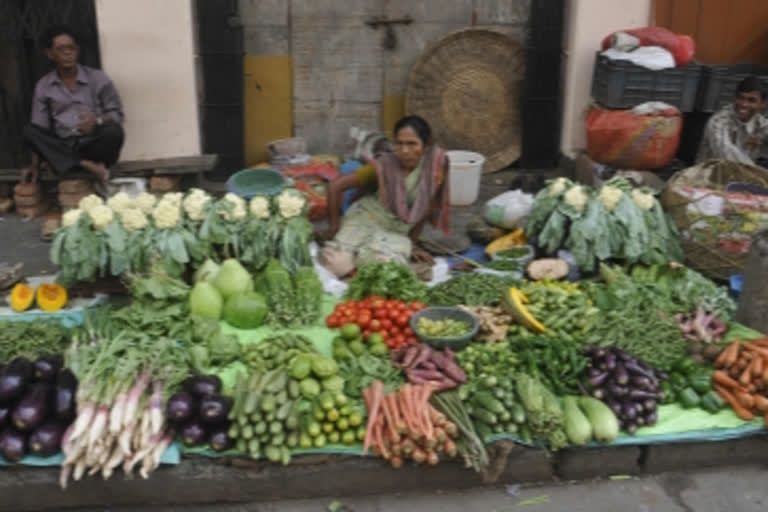New Delhi: India’s wholesale prices, measured as the wholesale price index (WPI), remain in double digits through the last financial year which ended last month. With the March WPI at 14.55%, the wholesale inflation for the fiscal turned out to be 12.96%, which is the highest annual inflation in the last 30 years, mainly due to rising commodity prices and a low base of FY 2020-21, when the annual wholesale inflation was just 1.3%.
The wholesale prices jumped to 14.55% in March after coming in at 13.11% in February this year. With this, the WPI inflation completed the distinction of remaining in double-digits in each and every month of the last financial year (April-March 2022 period). Sunil Sinha, Principal Economist at India Ratings and Research, says despite a high base of 7.89% in March last year, the wholesale inflation in March this year is the second-highest in 2011-12 series.
Sinha says the wholesale inflation at 12.96% in the financial year 2021-22 is a 30-year high driven by both rising commodity prices and a low base of 1.3% in the financial year 2020-21. “The surge in wholesale inflation is fairly broad-based as all the three major categories namely primary article, fuel & power and manufacturing recorded double-digit inflation in March 2022,” Sunil Sinha said in a statement sent to ETV Bharat.
According to the latest data released by the office of the economic adviser, under the ministry of commerce and industries on Monday, under the primary articles, price rise in food articles such as cereals, fruits and vegetables, eggs, meat and fish, condiments and spices either were either in high single-digit or double-digit.
Similarly within non-food articles segments such as fibres, floriculture, and oil seeds also witnessed high double-digit inflation in March this year. The remaining two segments of primary articles namely minerals and crude petroleum and natural gas witnessed inflation of 19.46% and 69.20% respectively in March.
Sinha, who closely tracks macro-economic data for Fitch Group company India Ratings, says the fuel and power inflation which was on a declining trajectory reversed its trajectory in March this year and increased to 34.5% as against 31.5% a month ago. “The fuel and power inflation was led by a very high inflation in major categories such as petrol, diesel & electricity in March 2022,” noted the economist.
Wholesale inflation in energy items
According to the latest official data, though the inflation in petrol, diesel and LPG moderated to 53.4%, 52.2% and 24.9% respectively in March this from the peak of 89.7%, 87.1% and 66.6% respectively in November last year but inflation of these fuel daily use fuel products remained at a very high level. Moreover, the wholesale prices for electricity surged to a record high of 21.8% in March this year.
Manufacturing inflation in double digits
The manufacturing inflation which was in high single digits in January and February this year rose to double digits in March at 10.71%. This is a cause of concern as manufacturing items account for nearly two-thirds weight in the basket of items whose wholesale prices are tracked by the government.
Edible Oils
High wholesale prices of edible oils remain a cause of concern for the government and policymakers as wholesale inflation of edible oils increased to 16.06% in March from 14.9% in February this year. March is the 28th straight month when the wholesale inflation of edible oils remained in double digits despite the government announcing several measures including imposing stock limits on traders and processors.
Core inflation also remained in double digits as it increased to 10.9% in March as against 10% in February this year. “This was led primarily by an uptick in inflation of manufactured items such as basic metals, chemicals and textiles. As the margins of the manufacturers have been under pressure due to the rising input costs, transportation and logistics they are passing on these into their output prices leading to higher inflation in manufactured products,” Sinha explained.
According to Sunil Sinha, the higher input cost, especially the cost of raw materials have got aggravated due to the Russia Ukraine conflict. Sinha says as the conflict does not seem to be coming to end soon the headwinds arising out of the disruption in the global supply chain coupled with uncertainty will continue to put pressure on domestic wholesale inflation.
Though the impact of the Russia-Ukraine conflict, which started on February 24, remained mostly negative for the world economy and also for the Indian economy, there are some positives signs as well. Sunil Sinha says the nominal GDP has turned out to be better than expected due to higher inflation leading to much higher tax collections than anticipated earlier. Secondly, due to the supply disruption of wheat from Russia and Ukraine, India is now exporting wheat in the global market.
Last week Egypt cleared wheat supplies from India due to supply disruptions from its traditional suppliers Russia and Ukraine. India’s wheat exports are expected to remain at a high level in the near term due to the supply chain disruption caused by export restrictions imposed by Indonesia and also due to the ongoing war between Russia and Ukraine.
“On the whole, India Ratings & Research expects the wholesale inflation to remain in high single digits in FY23 despite high base of last year kicking in from April 2022,” Sunil Sinha said in his forecast for the current financial year.



